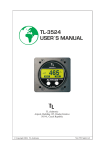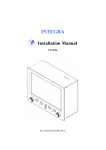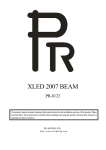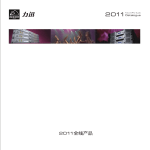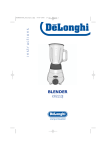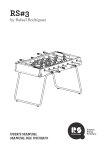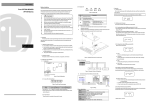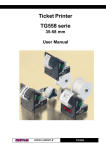Download Short installation and maintenance manual for TR541a TLC scanner
Transcript
Short installation and maintenance manual for TR541a TLC scanner Service group 2006 Contents I II Introduction 5 Installation steps 9 1 X-Y table lock device 11 2 Sample holder 13 3 Cables 15 4 Running LabChrom2 software 17 III 21 Maintenance 5 Lamp 23 6 Belts and bearings 33 4 CONTENTS Part I Introduction 5 7 This short manual covers the installation and basic maintenance methods of TR-541a TLC scanner. If your instrument is delivered without pre-installed xenon lamp (in case of air parcel), the lamp installation procedure can be find in the Maintenance part of the manual in Chapter Lamp change. This manual does not contain comprehensive and highly detailed error detection and fixing methods, those are in the Service Manual. 8 Part II Installation steps 9 Chapter 1 X-Y table lock device Open the sample compartment door. On right side you find an M4 Philips type screw. Remove this screw (see figure 1.1) and move the table left. Figure 1.1: Lock screw place on the table 11 12 CHAPTER 1. X-Y TABLE LOCK DEVICE You find a hexagonal shape M4 brass spacer, remove with a 7mm wrench. You can move the table forward. On the base plate you find a small metal block (see figure 1.2), locked by 2 screws that can be removed safely. Figure 1.2: Metal block The table is ready to use. Recommended to retain these accessories, if you deliver the instrument you should fix the table with them again. Chapter 2 Sample holder Slide your layer into the sample holder. If you use thin layers (aluminium based), you have to apply the metal filler, in case of glass based layers you dont. See the layer orientation on figure 2.1. Figure 2.1: Layer holder 13 14 CHAPTER 2. SAMPLE HOLDER There are two ears on the back side of the layer holder, fit them in to the slots of the X-Y-table, set horizontal the layer holder, then screw about 1/8 on the locks, the layer holder is fixed. Figure 2.2: Layer lock Chapter 3 Cables Connect the serial (RS232) cable to the back of the instrument, see figure 3.1. The two tails of the cable differs, the male goes to the instrument, the female to the computer. Connect to Com1 port (sometimes signed by A) of the computer. Figure 3.1: Back of the instrument 15 16 CHAPTER 3. CABLES Chapter 4 Running LabChrom2 software This chapter covers only the test functions of the LabChrom2 software, the measuring and data processing are detailed in the User’s manual. Turn ON the computer and the display. Wait until the login screen appears. The factory default login is: Login name: labor Password: labor You will find a LabChrom2 icon on the screen, duoble-click on it. Figure 4.1: LabChrom2 icon 17 18 CHAPTER 4. RUNNING LABCHROM2 SOFTWARE The main window will appear on the screen, see figure 4.2. You should select the Measure function by pressing the Measure button. Figure 4.2: Main window The measure window will appear, you shuold select the Service function by pressing Service button. Figure 4.3: Measure window 19 In the Service window you can check the functionality of the instrument. Figure 4.4: Service window Move the table in the sample compartment to center by hand and press X Home button. The table must move promptly to the zero position. If does not happen anything usually means there is communication failure between computer and instrument. 1. Press Re-init button and try again 2. Press Reset button in the instrument’s sample compartment (wait until the table moves tho zero position then remove to center again), Re-init and try again 3. Check the cable, fix it, check position (Com1-Com2) 4. Exit from LabChrom2 and start again 20 CHAPTER 4. RUNNING LABCHROM2 SOFTWARE Part III Maintenance 21 Chapter 5 Lamp This chapter covers the lamp installation and change change procedure too. To access the lamp and other electronic parts of the instrument remove the outesr screws on back of the instrument (see figure 3.1) then the three inner screws in the sample compartment, see figure 5.1. First push back the cover then pull up. Figure 5.1: Instrument cover screws in the sample compartment 23 24 CHAPTER 5. LAMP For any lamp operation you must remove the small side cover, near sample compartment. You find three screws in the right side of sample compartment, see figure 5.2. Do not remove these screws totally, screw only about five rounds off because these screws push the cover, see figure 5.3. Figure 5.2: Side cover pushing screws in the sample compartment Figure 5.3: Side cover removed 25 If you dislocate the screws you can remove the cover, see figure 5.4. Figure 5.4: Removing of side cover 26 CHAPTER 5. LAMP For the operations on lamp – lamp change or lamp current measure – you should remove the lamp inner cover. Remove the three screws that fix the cover, see figure 5.5 and figure 5.6. Figure 5.5: Left side of lamp compartment Figure 5.6: Right side of lamp compartment 27 When you removed the inner lamp cover, you access to the four lamp mechanic fixing screws and the lamp-power cables, see figure 5.7. First remove the power cables with 7mm wrench. Warning, there are two washers and can jump off from the bolt. Do not lose them! Then remove the four screws that hold the lamp assembly. For this operation you should wear safety glasses and cotton glove! Figure 5.7: Lamp cover off 28 CHAPTER 5. LAMP When you remove the cable fixing nuts, the other nuts on the bolt usually loose. Tight them gently (see figure 5.8), but • do not overtight, do not deform the teflon spacers • do not screw the internal lamp cables Do not touch the lamp bulb with your hand! If you change the lamp, slack the bottom screw first, remove the plug then slack the upper screw that holds the lamp. Warning, the lamp is asymmetrical, the bigger electrode is the upper, the lamp end thickness differ. Very important, do not overtight the lamp fixing and lamp plug screws! Figure 5.8: Lamp off 29 When you assembled back the lamp assembly and the the power cables, you should remove the optic cover, that fixed by four screws on its corners, see figure 5.9. Figure 5.9: Optical compartment After a lamp change you must adjust the lamp position. Re-assemble the lamp assembly, remove the four screws from the cover of optic and turn on the instrument. 30 CHAPTER 5. LAMP First turn the filter holder to the green filter, you can check the light spot on the first mirror by a small piece of white paper, usually a business card, see figure 5.10. Figure 5.10: Optical settings first step 31 Then look the pattern of the light spot on the slit, see figure 5.11. The leftright position of the light spot can be set by the left-right screws on the lamp assembly, see figure 5.7. The coarse adjustment of the spot height can be set by the lamp position in the lamp assembly, that means you have to remove the lamp assambly again after 5 minutes cooling. The fine positioning can be set by the screw on the top of the lamp assembly. Figure 5.11: Settings on slit of light beam When you positioned correctly the lamp, you must see the pattern on the mask as shown on figure 5.11 and a small light spot in the sample compartment on the layer. 32 CHAPTER 5. LAMP Chapter 6 Belts and bearings Disassembling the X-Y-table is usually a maintenance method, the belts do not break away in daily practice. The aim of the disassembling is the cleaning and greasing the bearings. The recommended material for cleaning and greasing is the WD-40 spray, but you can use other degreasing and lubricating materiels, fine oils. First remove the sample holder from the X-Y-table (see figure 6.1) and clean the pillows see figure 6.2. Figure 6.1: Removing sample holder from the X-Y table 33 34 CHAPTER 6. BELTS AND BEARINGS Figure 6.2: Sample holder bearing pillows There is a flat cable attached to the bottom of the X-Y-table, remove it, see figure 6.3. The connector is fixed by two fixing ears, tilt them. Figure 6.3: Removing cable from the bottom of the X-Y table 35 To remove the X-Y-table from the sample compartment you must remove the Y-shaft first. The Y-shaft is held by a small metal block, see figure 6.4 and 6.5. Figure 6.4: Removing table shaft holder Figure 6.5: The table shaft holder block 36 CHAPTER 6. BELTS AND BEARINGS Gently lift the free end of the shaft then pull out from sample compartment by the direction shown on figure 6.6. Figure 6.6: How to pull out the shaft Move the toothed belt forward-backward about one centimeter and pull off from toothed wheel, shown on figure 6.7. Figure 6.7: Toothed belt removing 37 Remove the toothed belt from the Y-motor shaft’s toothed wheel, figure 6.8. Figure 6.8: Removing belt from motor You can remove the complete X-Y-table from the sample compartment. Warning, only the direction is working that shown on figure 6.9. Figure 6.9: Removing the table from sample compartment 38 CHAPTER 6. BELTS AND BEARINGS Remove the screw from the end of the near X-shaft and pull out the shaft. Clean and lubricate thin the shaft. The X bearing house is fixed to the toothed belt by a small screw, remove it. Clean and grease (lubricate with oil or WD40 thin) the pillows in the bearing house. The rear X-shaft should not be removed, only clean and lubricate it in assembled state, because the rear bearings are only slide on it, see figure 6.2. Figure 6.10: Removing X-shaft and bearing house from the table 39 Clean the pillows with lubricated paper tissue. Figure 6.11: Cleaning X pillow The Y bearing house should not be removed for the cleaning. Figure 6.12: Cleaning Y pillow and the other X shaft







































